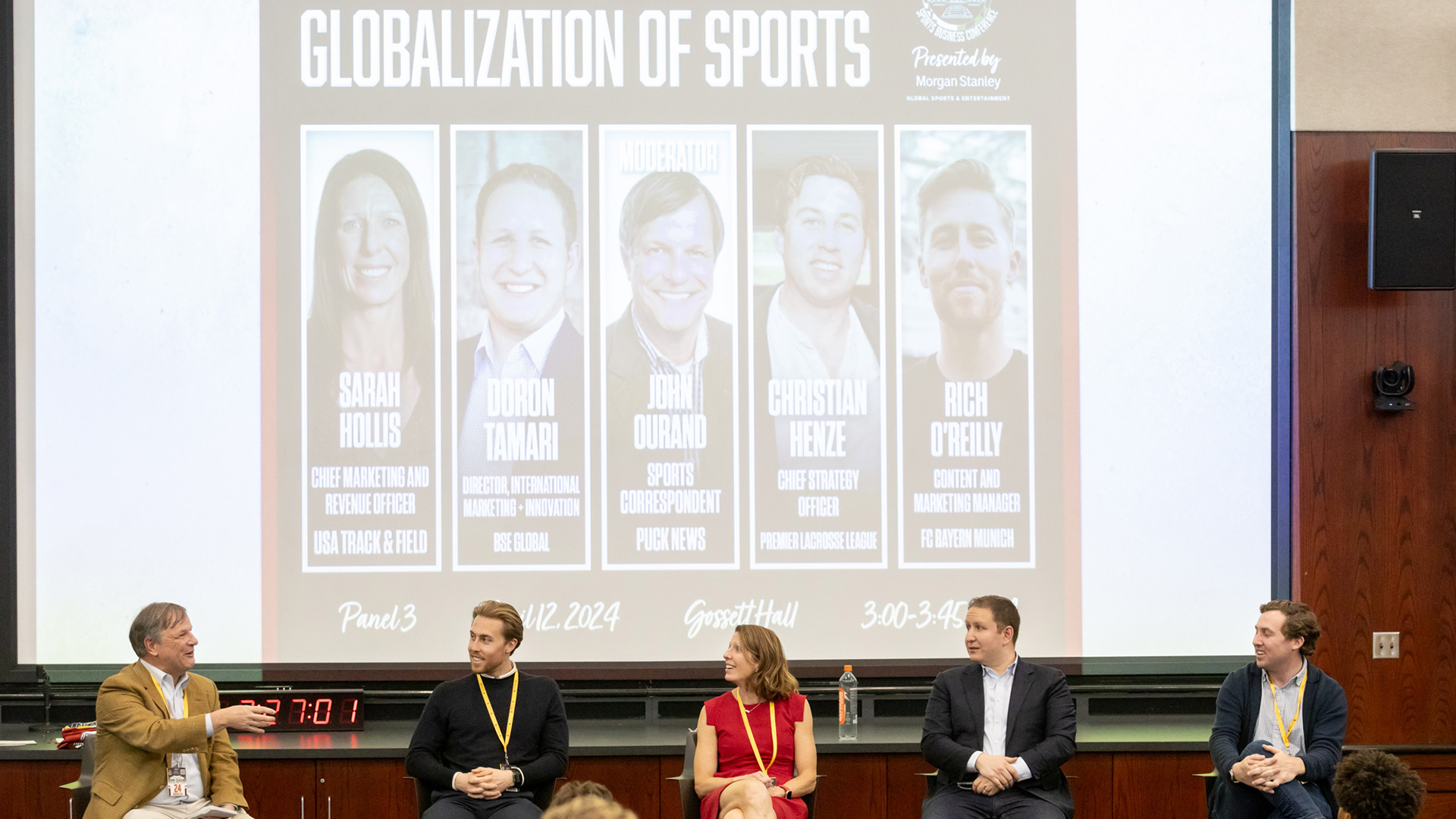
As a cultural staple worldwide, sports represent a medium transcending linguistic boundaries. Where there are sports fans, there is potential for leagues and franchises to grow their sport, and several executives shared their strategies to capture that potential at the fourth annual Maryland Sports Business Conference on Friday, April 12.
Hosted by the University of Maryland’s Robert H. Smith School of Business’ Sports Business Society and presented by Morgan Stanley Global Sports and Entertainment, this year’s conference addressed topics such as the evolution of fan engagement, the impact of name, image and likeness opportunities on collegiate sports and the future of youth sports.
The conference, held at Gossett Hall, included a panel discussion about the globalization of sports. The panel, moderated by Puck News’ John Ourand, featured Sarah Hollis, chief marketing and revenue officer at USA Track and Field (USATF), Doron Tamari ’11, director of international marketing and innovation at BSE Global, Christian Henze, chief strategy officer at Premier Lacrosse League, and Rich O’Reilly, content and marketing manager at FC Bayern Munich.
Together, the panelists offered insights from their experiences and lessons from expanding their brands and sports to global audiences. Here is what they had to say:
Grow at the grassroots level. In his work with BSE Global, which oversees the Brooklyn Nets, Tamari noted the significance of the team’s January regular-season showcase game in Paris against the Cleveland Cavaliers. It served as a unique opportunity for the franchise to represent the NBA abroad and establish touchpoints with potential new fans.
The organization developed promotional events leading up to the game centered around five pillars—sports, music, art, fashion and food. Tamari said that the most organic marketing efforts came from their youth basketball clinics during the trip. “When you get a kid to try it and love it, it's going to work more than almost anything else you can do,” he said. “I became a Nets fan when I was six, and it has stuck with me my whole life. Grassroots work is key to almost anything you want to do.”
Clear cultural hurdles. At FC Bayern Munich, a historically successful German soccer club, O’Reilly is focused on translating the brand’s success to the U.S. In Germany, “Bayern Munich is everything,” he said, but even with over 100 million followers across its social media channels, the club is competing for fan engagement abroad against teams from Spain’s La Liga and England’s Premier League.
Germany has a population of roughly 84 million people, but the U.S. has nearly 100 million soccer fans alone, presenting a “huge market that has to be tapped into.” One of the simplest methods to achieve that goal is increasing the league’s presence in streaming and broadcasting. “Growing up, I couldn’t watch the Bundesliga. Now, fans are going to bars on the weekends to stream our games. There’s a huge potential now that wasn’t previously there,” said O’Reilly.
Capitalize on major momentum. According to the Sports Business Journal, the Premier Lacrosse League eclipsed its highest viewership for any outdoor professional lacrosse game, with 543,000 average viewers during the 2023 season opener. Now, Henze is keeping the ball rolling by helping the oldest sport in the U.S. prepare for the 2028 Olympic Games in Los Angeles, marking its first return to the games as a medal sport since 1908. At LA28, men’s and women’s lacrosse will follow a sixes format, a more fast-paced and compact version of the sport intended to promote scoring and increase fan enthusiasm.
“Talking to the LA 2028 committee, it wanted sports with tradition and room to grow while appealing to younger audiences. Lacrosse has been the fastest-growing sport in America over the last 20 years and one of the fastest-growing sports worldwide,” said Henze. “When we first started the PLL in 2018, there were 60 sanctioned nations that played the sport of lacrosse. There are 92 now, just in that short period, and I expect that to be well over a hundred in the next couple of years.”
Focus on the stars. Like Henze, Hollis and USATF see LA28 as a significant branding opportunity for the sport. Track and field, however, poses its own unique challenges. Despite Team USA’s status as the number one team in the world, the sport falls outside of the top five in popularity in the U.S. The team’s athletes, Hollis said, earn larger appearance fees and are generally more popular across Europe. Generating that same popularity requires bringing fans closer to the action and familiarizing them with big names like Allyson Felix and Noah Lyles.
Another challenge lies in the continuity of Olympic athletes. “Developing stars is one of the biggest challenges that we face. Roughly 81% of our athletes on the Tokyo team were first-time Olympians. It’ll be similar in Paris and Los Angeles,” said Hollis. “We’ll need to shine a light on these athletes and make sure that the excitement of the Olympic Games doesn’t fall off. We need to take advantage of our home games while we have the focus of the world here.”
Media Contact
Greg Muraski
Media Relations Manager
301-405-5283
301-892-0973 Mobile
gmuraski@umd.edu
About the University of Maryland's Robert H. Smith School of Business
The Robert H. Smith School of Business is an internationally recognized leader in management education and research. One of 12 colleges and schools at the University of Maryland, College Park, the Smith School offers undergraduate, full-time and flex MBA, executive MBA, online MBA, business master’s, PhD and executive education programs, as well as outreach services to the corporate community. The school offers its degree, custom and certification programs in learning locations in North America and Asia.